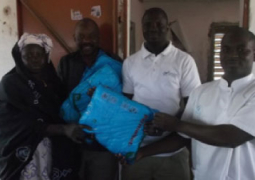
This is the time to uphold women’s achievements, recognize challenges, and focus greater attention on women’s rights and gender equality to mobilize all people to do their part. The Beijing Platform for Action focuses on 12 critical areas of concern, and envisions a world where each woman and girl can exercise her choices, such as participating in politics, getting an education, having an income, and living in societies free from violence and discrimination.
To this end, the theme of this year’s International Women’s Day is the clarion call of UN Women’s Beijing+20 campaigns. Join governments and activists across the world in commemorating the ground-breaking Conference of 1995. We celebrate the many achievements that have come since then and galvanize action to address the gaps that still remain in making gender equality a reality.
International Women’s Day (IWD), also called International Working Women’s Day, is celebrated on March 8 every year.
In different regions the focus of the celebrations ranges from general celebration of respect, appreciation and love towards women to a celebration for women’s economic, political, and social achievements.
Started as a Socialist political event, the holiday blended in the culture of many countries, primarily in Europe, including Russia. In some regions, the day lost its political flavor, and became simply an occasion for men to express their love for women in a way somewhat similar to a mixture of Mother’s Day and Valentine’s Day.
In other regions, however, the political and human rights theme designated by the United Nations runs strong, and political and social awareness of the struggles of women worldwide are brought out and examined in a hopeful manner. This is a day which some people celebrate by wearing purple ribbons.
History
The earliest Women’s Day observance was held on February 28, 1909, in New York; it was organized by the Socialist Party of America in remembrance of the 1908 strike of the International Ladies’ Garment Workers’ Union.[3] There was no specific strike happening on March 8, despite later claims.
In August 1910, an International Women’s Conference was organized to precede the general meeting of the Socialist Second International in Copenhagen, Denmark. Inspired in part by the American socialists, German Socialist Luise Zietz proposed the establishment of an annual ‘International Woman’s Day’ (singular) and was seconded by fellow socialist and later communist leader Clara Zetkin, although no date was specified at that conference.
Delegates (100 women from 17 countries) agreed with the idea as a strategy to promote equal rights, including suffrage, for women.The following year, on March 19, 1911, IWD was marked for the first time, by over a million people in Austria, Denmark, Germany and Switzerland.
In the Austro-Hungarian Empire alone, there were 300 demonstrations.In Vienna, women paraded on the Ringstrasse and carried banners honouring the martyrs of the Paris Commune.Women demanded that women be given the right to vote and to hold public office. They also protested against employment sex discrimination.Americans continued to celebrate National Women’s Day on the last Sunday in February.
2015: Empowering Women - Empowering Humanity:
“To be truly trans formative, the post-2015 development agenda must prioritize gender equality and women’s empowerment. The world will never realize 100 per cent of its goals if 50 per cent of its people cannot realize their full potential. “
Secretary-General Ban Ki-moon
International Women’s Day is a time to reflect on progress made, to call for change and to celebrate acts of courage and determination by ordinary women who have played an extraordinary role in the history of their countries and communities.
This year’s theme, “Empowering Women - Empowering Humanity: Picture It!” envisions a world where each woman and girl can exercise her choices, such as participating in politics, getting an education, having an income, and living in societies free from violence and discrimination.
In 2015, International Women’s Day will highlight the Beijing Declaration and Platform for Action, a historic roadmap signed by 189 governments 20 years ago that sets the agenda for realizing women’s rights. While there have been many achievements since then, many serious gaps remain. This is the time to uphold women’s achievements, recognize challenges, and focus greater attention on women’s rights and gender equality to mobilize all people to do their part.
Key issues and linkages
• Reproductive health: Women, for both physiological and social reasons, are more vulnerable than men to reproductive health problems. Reproductive health problems, including maternal mortality and morbidity, represent a major – but preventable -- cause of death and disability for women in developing countries. Failure to provide information, services and conditions to help women protect their reproduction health therefore constitutes gender-based discrimination and a violation of women’s rights to health and life.
Stewardship of natural resources: Women in developing nations are usually in charge of securing water, food and fuel and of overseeing family health and diet. Therefore, they tend to put into immediate practice whatever they learn about nutrition and preserving the environment and natural resources.
• Economic empowerment: More women than men live in poverty. Economic disparities persist partly because much of the unpaid work within families and communities falls on the shoulders of women and because they face discrimination in the economic sphere.
Educational empowerment: About two thirds of the illiterate adults in the world are female. Higher levels of women’s education are strongly associated with both lower infant mortality and lower fertility, as well as with higher levels of education and economic opportunity for their children.
• Political empowerment: Social and legal institutions still do not guarantee women
CONCLUSION
equality in basic legal and human rights, in access to or control of land or other resources, in employment and earning, and social and political participation. Laws against domestic violence are often not enforced on behalf of women.
• Empowerment throughout the life cycle: Reproductive health is a lifetime concern for both women and men, from infancy to old age. UNFPA supports programming tailored to the different challenges they face at different times in life.
Experience has shown that addressing gender equality and women’s empowerment requires strategic interventions at all levels of programming and policy-making.
Of the 1.3 billion people who live in absolute poverty around the globe, 70 percent are women. For these women, poverty doesn’t just mean scarcity and want. It means rights denied, opportunities curtailed and Voices silenced. Consider the following:
• Women work two-thirds of the world’s working hours, according to the United Nations Millennium Campaign to Halve world poverty by the year 2015. The overwhelming majority of the labour that sustains life – growing food, cooking, raising children, caring for the elderly, maintaining a house, hauling water – is done by women, and universally this work is accorded low status and no pay. The ceaseless cycle of labor rarely shows up in economic analyses of a society’s production and value.
Women earn only 10 percent of the world’s income. Where women work for money, they may be limited to a set of jobs deemed suitable for women – invariably low-pay, low-status positions.
• Women own less than 1 percent of the world’s property. Where laws or customs prevent women from owning land or other productive assets, from getting loans or credit, or from having the right to inheritance or to own their home, they have no assets to leverage for economic stability and cannot invest in their own or their children’s futures.
• Women make up two-thirds of the estimated 876 million adults worldwide who cannot read or write; and girls make up 60 percent of the 77 million children not attending primary school. Education is among the most important drivers of human development: women who are educated have fewer children than those who are denied schooling (some studies correlate each additional year of education with a 10 percent drop in fertility). They delay their first pregnancies, have healthier children (each additional year of schooling a woman has is associated with a 5 to 10 percent decline in child deaths, according to the United Nations Population Fund).
National Women’s Day
National Women’s Day is an annual public holiday in South Africa on 9 August. This commemorates the national march of women on this day in 1956 to petition against the pass laws that required South Africans defined as “black” by The Population Registration Act to carry a ‘”pass,” an internal passport that severely restricted their movement. Each “pass” designated specific urban/metropolitan areas in which the bearer was authorized to live, work and travel. Within such areas, black South Africans were required to carry and produce their “pass” at all times, and were arrested if without one. As such, it served to maintain population segregation, control urbanisation, and manage migrant labour during the apartheid era.
The event
On 9 August 1956, more than 50,000 women staged a march on the Union Buildings in Pretoria to protest against the proposed amendments to the Urban Areas Act (commonly known as the pass laws) of 1950. They left bundles of petitions containing more than 100 000 signatures at prime minister J.G. Strijdom’s office doors. Outside they stood silently for 30 minutes, many with their children on their backs. The women sang a protest song that was composed in honour of the occasion: Wathint’Abafazi Wathint’imbokodo!(Now you have touched the women, you have struck a rock.). In the 54 years since, the phrase (or its latest incarnation: “you strike a woman, you strike a rock”) has come to represent women’s courage and strength in South Africa.
The march was led by Lilian Ngoyi, Helen Joseph, Rahima Moosa and Sophia Williams.
Other participants included Frances Baard, a statue of whom was unveiled by Northern Cape Premier Hazel Jenkins in Kimberley (Frances Baard District Municipality) on National Women’s Day 2009.
Since 9 August 1994, the day has been commemorated annually and is known as “Women’s Day” in South Africa. In 2006, a reenactment of the march was staged for its 50th anniversary, with many of the 1956 march veterans.
For further information, E Mail azadehhassan@yahoo.co.uk. Text on 002207774469/3774469
Author Dr Azadeh Senior Lecturer at the University of the Gambia, Senior Consultant in Obstetrics & Gynaecology, Head of the Department of Obs/Gynaecology Africmed


